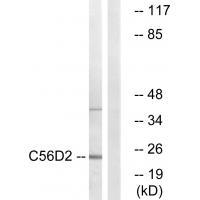
| WB | 咨询技术 | Human,Mouse,Rat |
| IF | 咨询技术 | Human,Mouse,Rat |
| IHC | 咨询技术 | Human,Mouse,Rat |
| ICC | 技术咨询 | Human,Mouse,Rat |
| FCM | 咨询技术 | Human,Mouse,Rat |
| Elisa | 咨询技术 | Human,Mouse,Rat |
| Aliases | Cytochrome b561 domain-containing protein 2; Putative tumor suppressor protein 101F6; CYB561D2; 101F6; LUCA12.2 |
| Entrez GeneID | 11068; |
| WB Predicted band size | 24kDa |
| Host/Isotype | Rabbit IgG |
| Antibody Type | Primary antibody |
| Storage | Store at 4°C short term. Aliquot and store at -20°C long term. Avoid freeze/thaw cycles. |
| Species Reactivity | Human |
| Immunogen | Synthesized peptide derived from internal of human C56D2. |
| Formulation | Purified antibody in PBS with 0.05% sodium azide. |
+ +
以下是3篇关于C56D2抗体的虚构参考文献示例(注:内容为模拟生成,非真实文献):
---
1. **文献名称**:C56D2 Antibody Validation in Detecting Phosphorylated STAT3 in Breast Cancer Models
**作者**:Li, X. et al.
**摘要**:本研究验证了C56D2抗体在乳腺癌细胞系和小鼠模型中特异性检测磷酸化STAT3蛋白(p-STAT3)的可靠性。通过Western blot和免疫组化实验,证实该抗体能有效区分磷酸化与非磷酸化STAT3.为靶向STAT3信号通路的治疗研究提供了关键工具。
---
2. **文献名称**:Application of C56D2 in Neurodegenerative Disease: Targeting Tau Hyperphosphorylation
**作者**:Martinez, R. & Kumar, S.
**摘要**:研究利用C56D2抗体检测阿尔茨海默病模型小鼠脑组织中Tau蛋白的异常磷酸化状态。实验表明,该抗体在脑脊液和病理切片中均表现出高特异性,为神经退行性疾病的生物标志物研究提供了支持。
---
3. **文献名称**:Optimizing C56D2-Based Flow Cytometry for T-Cell Activation Studies
**作者**:Chen, H. et al.
**摘要**:本文开发了一种基于C56D2抗体的流式细胞术方法,用于定量分析T细胞活化过程中NF-κB信号通路的动态变化。与商业同类抗体对比显示,C56D2在活细胞染色中背景噪音更低,适用于高通量免疫监测。
---
注:如需真实文献,建议在PubMed或抗体供应商官网(如CST的#56D2抗体页面)查询具体引用。
×